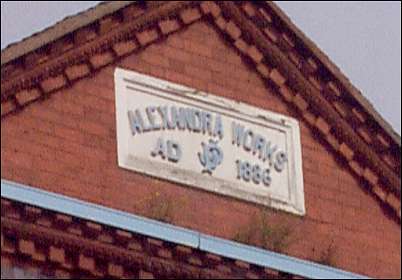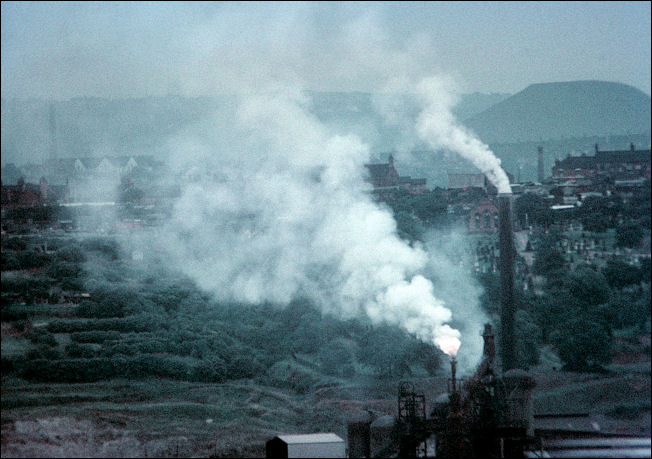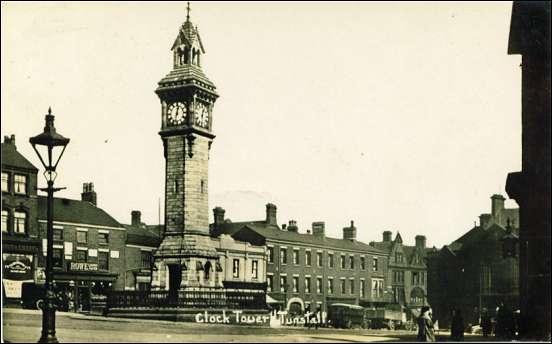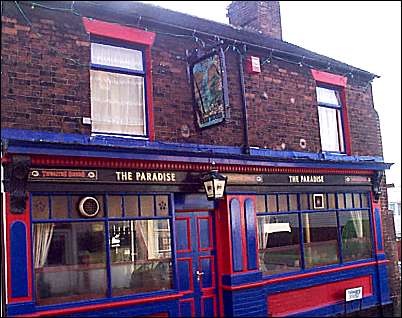|
Burslem lost its heart and Tunstall gained its
soul
There’s a lot going on in Tunstall these days
and at the moment it’s all about demolition and reconstruction. Booth’s Church works at the top of High Street along with Meakins’ Royal Albert have been bulldozed. The Alexandra Works in Scotia Road and the Unicorn Works have also disappeared leaving acres of town centre space available for commercial redevelopment.

Alexandra Works in Scotia Road

The Jasper Square
retail park was built on the site of the former Wedgwood Alexandra
pottery works which was built in 1886. The works were closed in October
2003.
Asda has already occupied the site of the Woodland Pottery and a new Matalan store is under construction nearby. Likewise on the southern edge of the town the giant Highgate works of Johnson’s and Richards’ have vanished as well. Meanwhile plans for a northern bypass are approaching a start date. Tunstall is changing and people who lived and worked here only twenty-five years ago wouldn’t recognise it today.
The line of the old lane approaching from Goldenhill
has already been dramatically interrupted by a wide roundabout with a KFC and a MacDonald’s perched on either side scowling competitively at each other. And an estate of houses nearby has wiped Bankey Fields from the map. Soon the city’s northern bypass will do the same for much of New Field and the Clanway valley, those ancient ways on which the town was established.
Tunstall High Street begins where it joins Summer Bank, a pleasant ridge that overlooks the once verdant vale of the Fowlea Brook much blighted by the ironworks at Goldendale that was lit by a perpetual flame that was said would never be extinguished: a forgotten icon of forgotten times, of an industry long gone.

Goldendale Iron Works
- c.1967
photo: Ken & Joan Davis
Here in the 1950’s many roads were renamed in tribute to half a
dozen American presidents in a policy to reduce duplicity throughout Stoke on Trent, though why obscure US statesmen were chosen nobody remembers. Indeed the names of most of Tunstall streets have been changed over a couple of generations.
Is it any wonder then that Tunstall folk have lost their sense of identity? This name-changing was a legacy from 1910 when post Federation planners believed there was a confusion of same-name streets. Actually residents weren’t at all confused it was the council that presumed they were. Two world wars put a stop to the instant renaming project but it was eventually addressed in the 1950’s, “We even made a mess of this,” comments Councillor Roger Ibbs, insinuating an example of civic diffidence. “The old people were confused and people all over the city were getting lost, a bit like today really with Stoke town and Hanley city centre.”
| New
Street Name |
Old
Street Name |
President |
years
in office |
| Jefferson
Street |
Cooper
Street |
Thomas
Cooper |
1801-1809 |
| Buren
Street |
Temple
Street |
Martin
Van Buren |
1837-1841 |
| Pierce
Street |
Charles
Street |
Franklin
Pierce |
1853-1857 |
| McKinley
Street |
Johnson
Street |
William
McKinley |
1897-1901 |
| Hoover
Street |
Chapel
Street |
Herbert
Hoover |
1929-1933 |
| Coolidge
Street |
Marsh
Street |
Calvin
Coolidge |
1923-1929 |
Tunstall streets renamed
in the 1950's in tribute to half a dozen American presidents
For myself I always had a feeling that Tunstall was a cuckoo’s nest – a place that had no indigenous population, a place that folk came to own by leaving their children to be brought up in the influence of others – opportunism in situ.
The main road runs continuously from the Sandyford roundabout to another huge island that mulishly separates the town centre from its bypass, Scotia Road. Not so long ago the main road travelled through High Street via Butterfield Place – Amicable Street that was before 1950 – creating a traffic bottleneck with no alternative route. When the long-planned extension to Scotia Road was implemented it was realised that the new police station had been sited on the wrong side when it was moved from Market Street – which became Wesley Street after 1950.

So much is changing these days that it’s impossible to see where it will all end and whether there’ll be a town after it’s all done. But who cares anyway? The old trade and traders have long gone and communities have turned around wholesale. Paul Hassall, the last of a dynasty of shoemakers, lived his early life in Tunstall. He remembers the demarcation between the communities that lived north of Tower Square and those below it. “I was born at 13 High Street, or as it was known before the 1950’s, number 1 High Street. The business was founded in Paradise Street. My grandfather the founder opened two more shops in Burslem. I remember that I knew nothing of the town above Tower Square. That’s how communities were then – insular. Probably still are.”
So what has caused the changes to the town that was once seen as a commercial upstart which earned it the name ‘plucky little Tunstall?’
“The demise of the pottery industry has been the biggest killer of towns,” claims Paul, “But it’s time for a complete change throughout the city and for my money Tunstall seems to be at the cutting edge of it.”

Clock Tower in Market
Square, Tunstall
the square was renamed Tower
Square in the 1950's
Malcolm Upright is the founder of one of Stoke on Trent’s premier architectural services, Hulme Upright, today situated in what he calls the Potteries ‘seventh town,’ Festival Park. An institution in his own right Malcolm Upright joined the Tunstall company of Cotton, Son and Hulme as an articled clerk in 1931 a firm that had, “very small offices in Piccadilly Street.
They were so small,” Malcolm remembers, “that we dropped the suffix ‘street’ to make it sound more important.” He spent his early years designing advanced structures for the pottery industry becoming the industry’s most respected consultant. He remembers the town being run on the wealth of pottery economics by the great names of Booths, Grindley’s, Adams’ and of course Johnson’s.
“In Tunstall in my formative days there were many respected businesses and businessmen. Hollinshead’s solicitors occupied the premises next door. Worthington and Robertson were at Hollishead and Moody. Then there were Boons. The Naylor’s of course were pretty central to town affairs. Most councillors were traders and fought fiercely for their own corner. All those family businesses have disappeared. R K Bailey died recently aged ninety-nine. He was one of the last of the important Tunstall traders. They were all pretty well self-sufficient and ran the council to the benefit of their towns.”
The current traders in Tunstall are much more worried these days; large scale development has had an unsettling effect.
Brian Mack owns Replay Records in High Street and is also the chairman of the Chamber of Trade a strong organisation which has some 48 active members.
“Twenty years ago the town’s independent trade was thriving. I had four businesses in North Staffordshire now I’ve just got this one which has been hit by a quadruple whammy. The big superstores have taken my retail trade. Tied to this is the problem with downloading and copying from the internet. Thirdly the demise of the pottery industry has taken away daytime shoppers.”
On a personal note Brian is more worried about the fourth whammy – proposals to develop the Highgate site. “If there’s going to be a big Woolworth’s store there I may as well close shop now. The council and the government can’t get their acts together in planning for out of town shopping development. The Johnson’s application should be refused because it’s too close to the town. But the loophole is that because it is too close it can be considered a town centre site just like Asda and Matalan. Small town traders just can’t win.”

But the visual environment in the town certainly is a lot better than it was a generation ago. The market square facing the town hall and the redeveloped market hall portray a pretty picture with fruit trees and cobblestones providing an antiquated backdrop to a townscape with a traditional market feel.

The Paradise
- photo 2000 -
At the far end of the square I visit a charming public house with the appealing name ‘Paradise.’ Tunstall resident and manager Jim McCormick believes the town has benefited from the new developments. “There are certainly more people in Tunstall these days than there ever was. They come to Asda and in most cases they leave their cars parked there and walk the short distance into the town to go to the market and stroll around the other shops. It’s a huge success and a credit to the council. On the downside EU law has forced one of the best traditional shops in the city out of business. Modern Stores closed a few months ago because of the insistency of conforming to EU regulations on food packaging and refrigeration. The last traditional shop has closed and you can’t buy a bottle of milk or a loaf of bread now unless you walk across to Asda.”
It seems then that regulations and in some cases the tolerant application of them is changing Tunstall’s face as much as the closure of potbanks.
“It beats me,” complains Brian Mack, “why the council looks sympathetically on the big stores and yet seems to go out of its way to trip up the small traders. Thousands of people these days download music and films and are being allowed to sell them for a fraction of the proper retail price. I know of stalls operating in this way on council-run outdoor markets. Surely it’s the council’s role to protect traders like me?”
Tunstall is a town that past civic watchers would call an interloper. For many years it kept itself to itself and stood in isolation in the shadow of Burslem. But it has always seized opportunities when they have been presented. The majority of its residents past and present are themselves strangers on the shore.
Brian Mack comes from Manchester. Malcolm Upright also came from the north-west in the trail of his father whose profession was Methodist minister. Indeed one has only to look back to the 1930’s when those trader/aldermen from Burslem were faced with having to clear the slums from their own town centre. And where did they send their communities to? They acquired colliery land in Stanfields and built a large estate upon it. All right it’s nice for the people of Burslem to live ‘in the country’ but where is the nearest town centre to Stanfields? Why Tunstall of course. This must have been the time when Burslem lost its heart and Tunstall gained its soul. Now it seems Tunstall is racing ahead unstoppably.
Fred Hughes

|
![]()
![]()
![]()